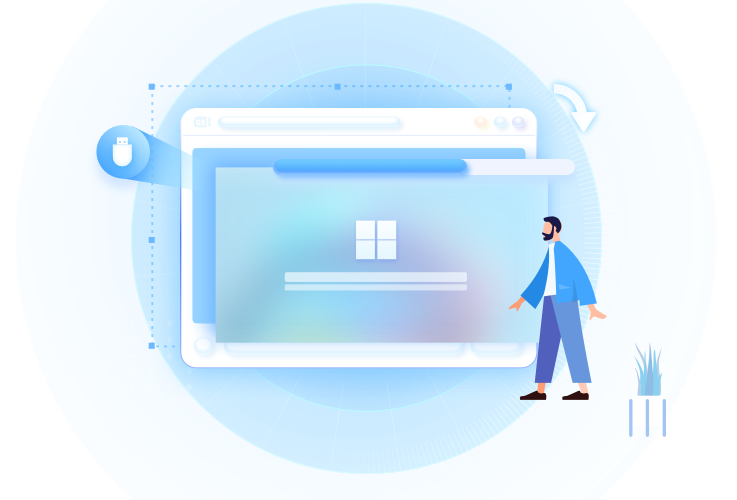If your Windows OS constantly lags or throws random errors, installing Windows 10 or Updating is better to eliminate the issues. Windows allows you to install Windows 10 from command prompt in 2 ways: with a USB or CD/DVD. EaseUS details installing Windows 10 from the command prompt and a much easier process with EaseUS OS2Go.
How to Install Windows 10 Without Using Command Prompt
Back in the old days, people used to remember CMD commands to perform all major tasks on the computer. However, CMD commands are complex and time-consuming. A simple error can move or erase all your data. Are you unfamiliar with CMD commands and looking for an easier way to install Windows 10? EaseUS OS2Go comes to your rescue.
With EaseUS OS2Go, you can create a Windows live USB with BIOS and UEFI support to boot your PC directly. The software lets you bypass the Windows system requirements like Secure Boot, Microsoft Account, TPM2.0, etc, to install Windows. For example, it lets you install Windows 10 without a Microsoft account. A simple click will clone the Windows 11/10/8/7 to a portable USB, helping you run the OS anywhere and at any time.
Unlike the Windows Media Creation Tool, OS2Go lets you create a bootable USB drive without the ISO file and install and run Windows OS on a USB or hard drive. This acts like a bootable disk, helps with portable Windows, and a backup. Download it now, and make a bootable USB with Windows 10.
Now that you have a bootable USB with the help of EaseUS OS2Go follow the steps below to install Windows 10 using it:
Part 1: Create a portable USB using EaseUS OS2Go
Step 1. Install EaseUS OS2Go on your Windows computer, it will display your system drive's used space. Plug in a USB drive that is larger than the system drive used space. Choose the target USB drive and click Next to continue.
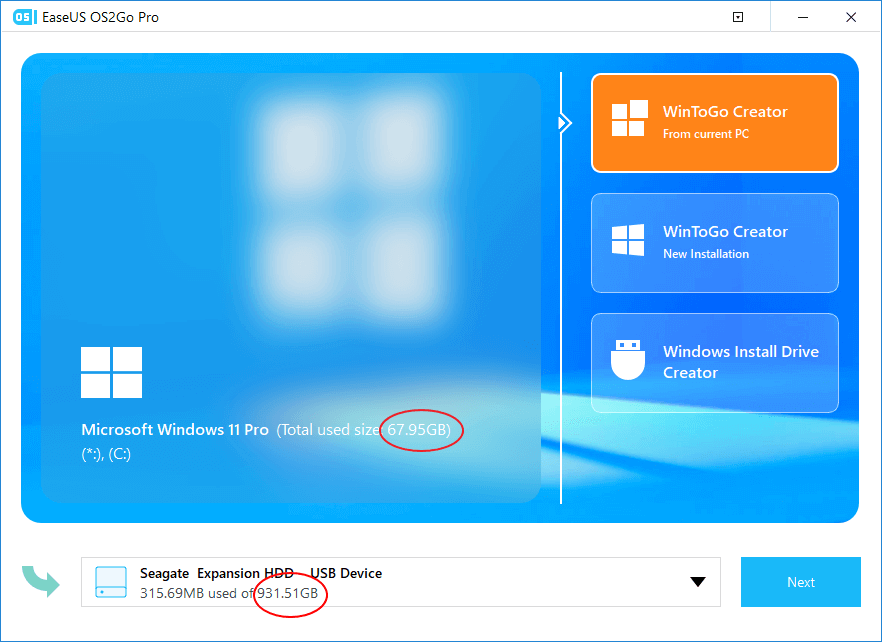
Step 2. EaseUS OS2Go will notify you that the following operation would delete all data on your drive. Make sure that you have backed up all the important data. Click the Continue button to proceed.
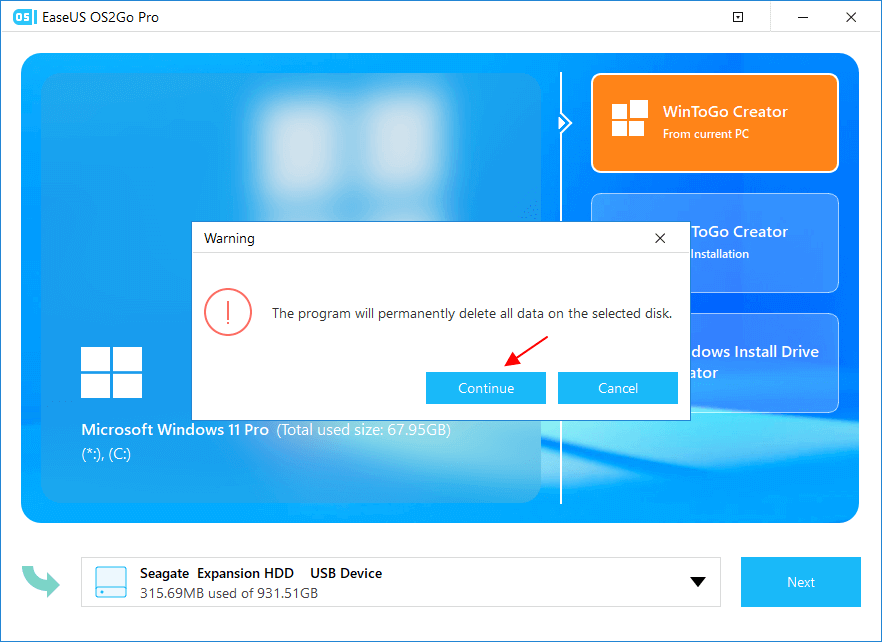
Step 3. Adjust disk layout. The default disk layout on the target drive will be exactly the same as the resource drive. You could also edit the layout according to your needs. Tick the option there if you're using a Solid State Drive as the Windows bootable drive. Next, click Proceed.
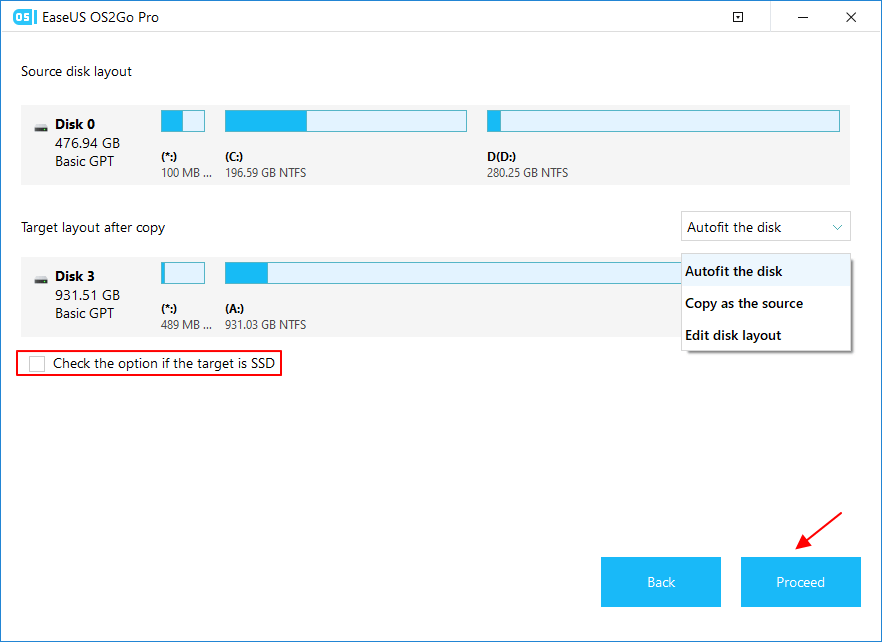
Step 4. Then EaseUS OS2Go will start to create the portable USB drive. It usually takes a while depending on your OS and Network condition. When the progress reaches 100%, the USB drive should be bootable now.
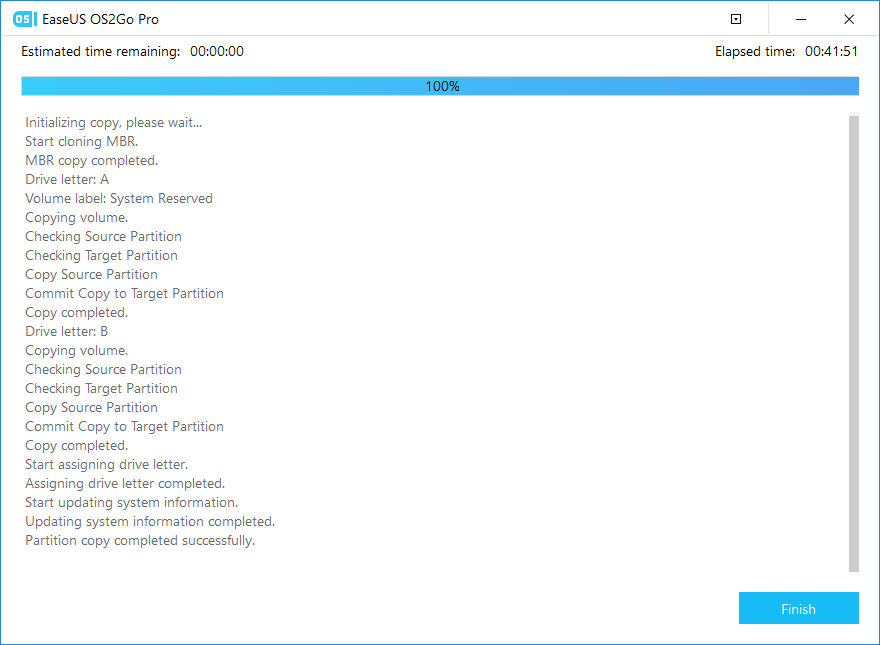
Step 5. Insert the portable Windows USB and start your computer. Press the required key (F2, DEL, F10...) to access BIOS. Choose to boot from the USB disk.
Note: Please make sure that the boot mode (UEFI or Legacy) of the portable USB and your target computer are the same, otherwise you may not be able to boot.
Part 2: Change the Boot order from BIOS
Once you insert the bootable Windows 10 USB, you need to change the boot order from BIOS to start from the USB.
Step 1. Enter the BIOS. To enter the BIOS, restart your Windows PC and continuously press the BIOS key while restarting to invoke the BIOS settings.
⭐Note: Depending upon the manufacturer, the BIOS can be anything from Del, Esc, F2, F10, F9, etc.
Step 2. Navigate to the Boot Options menu and change the boot order to the appropriate Boot Media Device.

Step 3. Save changes and restart the PC to boot with USB.
Part 3: Windows 10 installation with Bootable Media
Step 1. Once you turn on the PC, you will see a message about pressing a key to boot from the device.
Step 2. Once the Windows Setup loads, select the Setup options for language, edition, etc.

Step 3. Click Install Now.

Step 4. Enter your product key or accept the license terms when reading the Microsoft Software License Terms.

Step 5. Select Custom: Install Windows only (Advanced) option.

Step 6. Now, you have to choose the hard drive or partition to install Windows 10. Make sure you select the one with enough space to accommodate the OS.

Step 7. Once you complete the Windows 10 installation, click on Restart now.
If you want to learn how to install Windows 10 from BIOS from USB, you can refer to the following article.

How to Install Windows 10 from USB from BIOS
This guide will show you everything you need to know about installing Windows 10 from BIOS from USB on your computer. Read more >>
2 Common Ways to Install Windows 10 Command Prompt
If you frequently use Command Prompt and wish to install Windows with it. You can choose any of these methods to install Windows. You must download the Windows Media Creation Tool and mount the ISO files onto a drive for both methods.
- Way 1. Install Windows 10 from USB Using Command Prompt
- Way 2. Install Windows 10 from CD Using Command Prompt
Way 1. Install Windows 10 from USB Using Command Prompt
To install Windows 10 from USB, you need to make a bootable USB drive with installation files. You can reduce the installation time with a USB and directly boot the PC. Make sure to insert a USB with a size greater than 8GB to accommodate the required files.
Step 1. Press the Windows + R keys to open the Run dialog box. Enter the disk part and press OK to run the Diskpart command for Windows 10 install.
Step 2. Now, type the following commands one after the other, and press Enter for each command below.
- list disk
- select disk 1
- clean
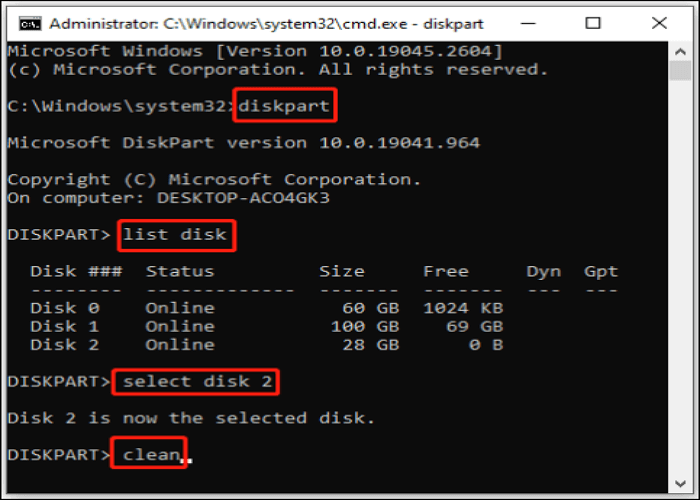
- create partition primary
- select partition 1
- active
- format fs=ntfs quick (or format fs=fat32 quick)
- assign letter=X
- exit
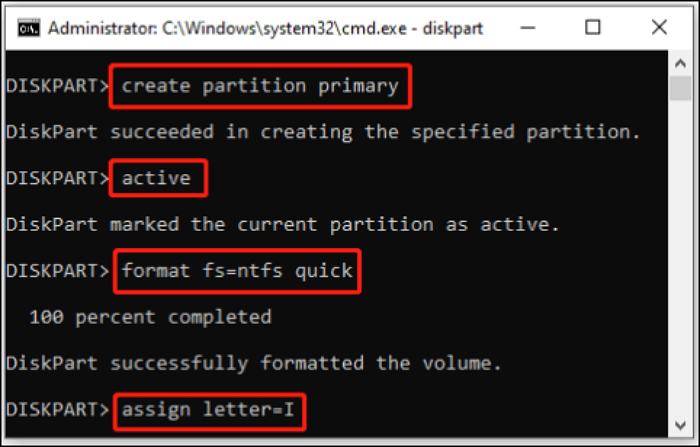
- Warning
- 1️⃣The Clean command will make all the data on the drive invisible. It marks all the data as deleted. Run the command to remove all the data from the USB and perform a clean install.
- 2️⃣Also, replace the 1 with the USB flash drive number and change the X to any available letter to use the USB drive.
Step 3. Now, you will have to navigate to the mounted Windows 10 ISO image and boot it using the command lines below:
- G:
- cd boot
- bootsect /nt60 X:
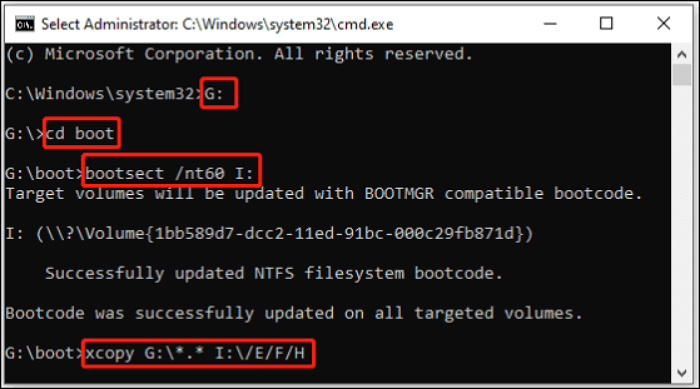
- Notice:
- 1️⃣You need to replace the letter G with the letter of your mount drive as it appears in the File Explorer.
- 2️⃣ Replace the X with the correct drive letter for the USB flash drive.
Step 4. Enter the below command to copy the image to the USB flash drive.
xcopy G:\*.* X:\ /E /F /H
Notes:
- /E- to copy all subfolders.
- /H- to copy all hidden files.
- /F- to display all source and destination files during copying.
Step 5. Now, you have the bootable USB flash drive to install Windows. Insert into the PC and install Windows with WinRE.
The steps to install Windows 10 with WinRE are given in the method below. Follow from step 4 to the end.
- Important
- The Windows 10 installation will remove everything on the PC's primary hard drive. If you do not want to lose data, back up important files.
Way 2. Install Windows 10 from CD Using Command Prompt
Let us see how to use a CD to install Windows 10 via Command Prompt.
Step 1. Open the Run dialog box (Windows + R). Enter diskpart, and click OK to open Diskpart for Windows 10 installation.
Step 2. Type the list vol and execute it to find the partition with ISO files.
Step 3. Enter G:\ISO_Files\setup.exe and execute the command.
Note: Replace the G with the disk number containing the mounted Windows 10 disc image.
Step 4. This prompts the Windows Setup page to open. Make the selections for language, time, currency, keyboard, and input methods, and click Next.
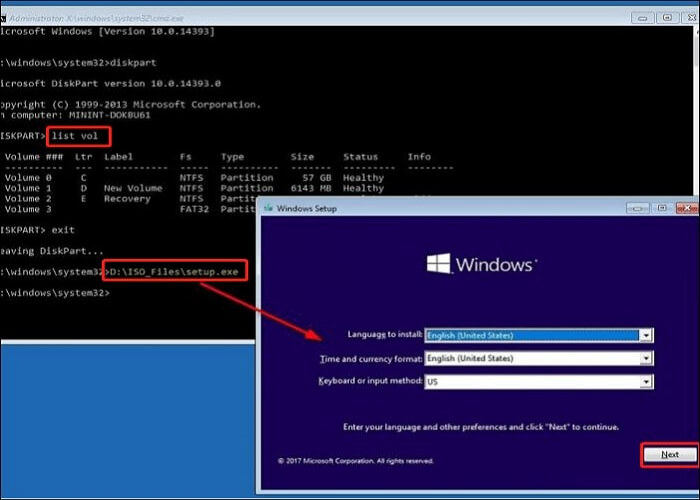
Step 5. Click Install now.
Step 6. If this is your first time installing Windows 10 on the PC, you must enter the genuine product key. If you are going for a reinstallation, click on the I don't have a product key and click Next.
Step 7. Select the Windows 10 edition you currently use if you choose I don't have a product key. Click Next and accept the license terms.
Step 8. In the type of installation window, go for Custom: Install Windows only (Advanced).
Step 9. Now, select the hard drive or partition to install Windows 10. Select the drive with enough free space to accommodate the OS.
Step 10. Once you complete the Windows 10 installation, click Restart now to restart the PC with Windows 10.
Share this article on your social media to help more people install Windows 10 with ease!
To Sum Up
You can install Windows 10 from command prompt using a USB or CD. The article details the process and commands to perform the Windows 10 installation. You can choose one of them based on what you have: USB or CD.
As you can see, creating a bootable USB or CD requires you to remember and execute complex CMD commands. Better go with EaseUS OS2Go to create bootable USB with simple steps and install Windows 10. Download it now, and start your Windows installation.
FAQs on Command Prompt Install Windows 10
Here are some frequently asked questions on installing Windows 10 from Command Prompt.
1. How to boot Windows 10 from Command Prompt?
To boot Windows 10 from CMD, open the command prompt with admin privileges. Enter:
- diskpart
- list vol
- G:\setup.exe
These commands will boot Windows 10.
2. How to restore PC with Command Prompt?
Open CMD as administrator, and enter the rstrui.exe command. Execute the command and follow the instructions in the System Restore Wizard to restore the PC.
3. How do I force my computer to boot from USB?
Turn off the device and insert the bootable USB drive into the PC. Now, turn on the device and use the UEFI menu to boot Windows from the USB.
4. Can you install Windows 10 through BIOS?
To boot Windows 10 from BIOS, connect a bootable installation media to the PC. Boot the system into BIOS, and use the Boot Options Menu to install Windows 10.
Was This Page Helpful?
Related Articles
-
How to Reinstall Windows 11 from BIOS on PC & Laptop🔥
![]() Jerry/2025-05-29
Jerry/2025-05-29 -
How to Create Bootable USB from ISO Windows 11 in 3 Different Ways
![]() Jerry/2025-05-28
Jerry/2025-05-28 -
Free Download Windows 8/8.1 (ISO File) for 32-Bit/64-Bit PCs
![]() Brithny/2025-03-28
Brithny/2025-03-28 -
How to Download Windows 11 ISO Without Media Creation Tool
![]() Jerry/2025-06-19
Jerry/2025-06-19
EaseUS OS2Go
- Create portable Windows to USB
- Copy installed Windows OS to USB
- Clone Winodws OS drive to USB
- Run Windows 11 on any PC
- Run Windows 11 on unsupported PC
- Run Windows 11/10 on a Mac
